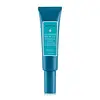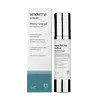What's inside
What's inside
 Key Ingredients
Key Ingredients

 Benefits
Benefits

 Concerns
Concerns

 Ingredients Side-by-side
Ingredients Side-by-side

Salicylic Acid 0.75%
MaskingWater
Skin ConditioningPropanediol
SolventButylene Glycol
HumectantOctyldodecanol
EmollientDimethicone
EmollientGlyceryl Stearate
EmollientCoco-Caprylate/Caprate
EmollientGlycerin
HumectantCetearyl Alcohol
EmollientTriheptanoin
Skin ConditioningOctadecenedioic Acid
EmulsifyingSilybum Marianum Extract
Skin ConditioningMagnesium PCA
HumectantAmylopectin
Niacinamide
SmoothingSuccinoglycan
Skin ConditioningBisabolol
MaskingNelumbo Nucifera Flower Water
TonicNymphaea Caerulea Flower Water
Skin ConditioningPalmitic Acid
EmollientLecithin
EmollientPhysalis Angulata Extract
Skin ProtectingAcetyl Glucosamine
Skin ConditioningCastor Oil/Ipdi Copolymer
Caprylic/Capric Triglyceride
MaskingDilinoleic Acid/Butanediol Copolymer
Carbomer
Emulsion StabilisingC9-12 Alkane
SolventBehenyl Alcohol
EmollientStearic Acid
CleansingDipropylene Glycol
HumectantPolysorbate 20
EmulsifyingDextrin
AbsorbentPolydextrose
HumectantCaprylyl Glycol
Emollient1,2-Hexanediol
Skin ConditioningCetyl Alcohol
EmollientLauryl Alcohol
EmollientMyristyl Alcohol
EmollientSodium Hydroxide
BufferingPhenoxyethanol
PreservativeTocopherol
AntioxidantSalicylic Acid 0.75%, Water, Propanediol, Butylene Glycol, Octyldodecanol, Dimethicone, Glyceryl Stearate, Coco-Caprylate/Caprate, Glycerin, Cetearyl Alcohol, Triheptanoin, Octadecenedioic Acid, Silybum Marianum Extract, Magnesium PCA, Amylopectin, Niacinamide, Succinoglycan, Bisabolol, Nelumbo Nucifera Flower Water, Nymphaea Caerulea Flower Water, Palmitic Acid, Lecithin, Physalis Angulata Extract, Acetyl Glucosamine, Castor Oil/Ipdi Copolymer, Caprylic/Capric Triglyceride, Dilinoleic Acid/Butanediol Copolymer, Carbomer, C9-12 Alkane, Behenyl Alcohol, Stearic Acid, Dipropylene Glycol, Polysorbate 20, Dextrin, Polydextrose, Caprylyl Glycol, 1,2-Hexanediol, Cetyl Alcohol, Lauryl Alcohol, Myristyl Alcohol, Sodium Hydroxide, Phenoxyethanol, Tocopherol
Water
Skin ConditioningPropanediol
SolventPotassium Azeloyl Diglycinate
Skin ConditioningPropylene Glycol
HumectantPolysorbate 20
EmulsifyingTitanium Dioxide
Cosmetic ColorantLecithin
EmollientTriethanolamine
BufferingAmmonium Acryloyldimethyltaurate/Vp Copolymer
Alcohol
AntimicrobialAcrylamide/Sodium Acryloyldimethyltaurate Copolymer
Emulsion StabilisingAcrylates/C10-30 Alkyl Acrylate Crosspolymer
Emulsion StabilisingAzelaic Acid
BufferingBenzyl Salicylate
PerfumingC13-14 Isoparaffin
EmollientCetylpyridinium Chloride
AntimicrobialCichorium Intybus Root Extract
MaskingCitronellol
PerfumingEthylhexylglycerin
Skin ConditioningHydrochloric Acid
BufferingHydrogenated Lecithin
EmulsifyingLaureth-7
EmulsifyingLeptospermum Scoparium Branch/Leaf Oil
TonicLinalool
PerfumingMelaleuca Alternifolia Leaf Oil
AntioxidantMica
Cosmetic ColorantNiacin
SmoothingPanthenol
Skin ConditioningPantolactone
HumectantParfum
MaskingPhenoxyethanol
PreservativePhytosphingosine Hcl
Skin ConditioningPotassium Sorbate
PreservativeRetinal
Skin ConditioningRetinyl Palmitate
Skin ConditioningSilybum Marianum Extract
Skin ConditioningSodium Chloride
MaskingSodium Cholate
Skin ConditioningSodium Hyaluronate
HumectantSodium Hydroxide
BufferingTin Oxide
AbrasiveTocopherol
AntioxidantTranexamic Acid
AstringentTriticum Vulgare Germ Extract
Skin ConditioningWater, Propanediol, Potassium Azeloyl Diglycinate, Propylene Glycol, Polysorbate 20, Titanium Dioxide, Lecithin, Triethanolamine, Ammonium Acryloyldimethyltaurate/Vp Copolymer, Alcohol, Acrylamide/Sodium Acryloyldimethyltaurate Copolymer, Acrylates/C10-30 Alkyl Acrylate Crosspolymer, Azelaic Acid, Benzyl Salicylate, C13-14 Isoparaffin, Cetylpyridinium Chloride, Cichorium Intybus Root Extract, Citronellol, Ethylhexylglycerin, Hydrochloric Acid, Hydrogenated Lecithin, Laureth-7, Leptospermum Scoparium Branch/Leaf Oil, Linalool, Melaleuca Alternifolia Leaf Oil, Mica, Niacin, Panthenol, Pantolactone, Parfum, Phenoxyethanol, Phytosphingosine Hcl, Potassium Sorbate, Retinal, Retinyl Palmitate, Silybum Marianum Extract, Sodium Chloride, Sodium Cholate, Sodium Hyaluronate, Sodium Hydroxide, Tin Oxide, Tocopherol, Tranexamic Acid, Triticum Vulgare Germ Extract
Alternatives
Ingredients Explained
These ingredients are found in both products.
Ingredients higher up in an ingredient list are typically present in a larger amount.
Lecithin is a term for a group of substances found in the cell membranes of plants, animals, and humans. They are made up of mixture of phospholipids.
This ingredient has emollient and emulsifying properties.
As an emollient, lecithen helps soften the skin and creates a barrier to keep moisture in.
As an emulsifier, it also helps prevent water and oil ingredients from separating. Lecithin can also help ingredients be better absorbed by the skin.
This is because the phospholipids in lecithin produce liposomes. Liposomes help other ingredients get through the skin barrier.
Depending on the source of this ingredient, lecithin may not be fungal acne safe. This is because some sources of lecithin come from soybean oil, which may feed the malassezia yeast that feeds fungal acne.
We recommend reaching out to the brand you are purchasing from to inquire about the source of their lecithin.
Some other names for this ingredient include soy lecithin and deoiled soy lecithin.
Learn more about LecithinPhenoxyethanol is a preservative that has germicide, antimicrobial, and aromatic properties. Studies show that phenoxyethanol can prevent microbial growth. By itself, it has a scent that is similar to that of a rose.
It's often used in formulations along with Caprylyl Glycol to preserve the shelf life of products.
Polysorbate 20 is made by combining ethoxylation of sorbitan, ethylene oxide, and lauric acid. It is a mild cleansing agent, surfactant, and emulsifier.
As a surfactant, it helps collect dirt and oils for washing. Emulsifiers prevent oils and water from separating.
Polysorbate 20 also adds scent to a product. Since it is made using sorbitol, it has a sweet scent. Sorbitol can also be found in fruits such as apples and peaches.
The lauric acid used to create Polysorbate 20 is often derived from coconuts.
Polysorbate 20 may not be fungal acne safe.
Learn more about Polysorbate 20Propanediol is an all-star ingredient. It softens, hydrates, and smooths the skin.
It’s often used to:
Propanediol is not likely to cause sensitivity and considered safe to use. It is derived from corn or petroleum with a clear color and no scent.
Learn more about PropanediolWe don't have a description for Silybum Marianum Extract yet.
Sodium Hydroxide is also known as lye or caustic soda. It is used to adjust the pH of products; many ingredients require a specific pH to be effective.
In small amounts, sodium hydroxide is considered safe to use. However, large amounts may cause chemical burns due to its high alkaline.
Your skin has a natural pH and acid mantle. This acid mantle helps prevent harmful bacteria from breaking through. The acid mantle also helps keep your skin hydrated.
"Alkaline" refers to a high pH level. A low pH level would be considered acidic.
Learn more about Sodium HydroxideTocopherol (also known as Vitamin E) is a common antioxidant used to help protect the skin from free-radicals and strengthen the skin barrier. It's also fat soluble - this means our skin is great at absorbing it.
Vitamin E also helps keep your natural skin lipids healthy. Your lipid skin barrier naturally consists of lipids, ceramides, and fatty acids. Vitamin E offers extra protection for your skin’s lipid barrier, keeping your skin healthy and nourished.
Another benefit is a bit of UV protection. Vitamin E helps reduce the damage caused by UVB rays. (It should not replace your sunscreen). Combining it with Vitamin C can decrease sunburned cells and hyperpigmentation after UV exposure.
You might have noticed Vitamin E + C often paired together. This is because it is great at stabilizing Vitamin C. Using the two together helps increase the effectiveness of both ingredients.
There are often claims that Vitamin E can reduce/prevent scarring, but these claims haven't been confirmed by scientific research.
Learn more about TocopherolWater. It's the most common cosmetic ingredient of all. You'll usually see it at the top of ingredient lists, meaning that it makes up the largest part of the product.
So why is it so popular? Water most often acts as a solvent - this means that it helps dissolve other ingredients into the formulation.
You'll also recognize water as that liquid we all need to stay alive. If you see this, drink a glass of water. Stay hydrated!
Learn more about Water